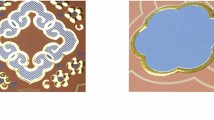Abstract
This study discusses the optimal design of an automatic inspection system for processing light-emitting diode (LED) chips. Based on support vector machine (SVM) with optimal theory, the classifications of micro-defects in light area and electrode area on the chip surface, and develop a robust classification module will be analyzed. In order to design the SVM-based defect classification system effectively, the multiple quality characteristics parameter design. The Taguchi method is used to improve the classifier design, and meanwhile, PCA is used for analysis of multiple quality characteristics on influence of characteristics on multi-class intelligent classifier, to regularly select effective features, and reduce classification data. Aim to reduce the classification data and dimensions, and with features containing higher score of principal component as decision tree support vector machine classification module training basis, the optimal multi-class support vector machine model was established for subdivision of micro-defects of electrode area and light area. The comparison of traditional binary structure support vector machine and neural network classifier was conducted. The overall recognition rate of the inspection system herein was more than 96%, and the classification speed for 500 micro-defects was only 3 s. It is clear that we have effectively established an inspection process, which is highly effective even under disturbance. The process can realize the subdivision of micro-defects, and with quick classification, high accuracy, and high stability. It is applicable to precise LED detection and can be used for accurate inspection of LED of mass production effectively to replace visual inspection, economizing on labor cost.














Similar content being viewed by others
References
Azadeh, O., & Nasser, S. (2011). An efficient hybrid algorithm for multi-class support vector machines. In: International conference on computer science and information technology June 10–12 (pp. 24–28). Chengdu, China.
Chang, C. C., & Lin, C. J. (2012). LIBSVM: A library for support vector machines. ACM Transactions on Intelligent Systems and Technology, 2, 27:1–27:27. (2011).
Chang, C. Y., Chang, C. H., Li, C. H., & Jeng, M. D. (2008). Learning vector quantization neural networks for LED wafer defect inspection. International Journal of Innovative Computing, Information and Control, 4(10), 2565–2579.
Chang, F., Guo, C. Y., Lin, X. R., & Lu, C. J. (2010). Tree decomposition for large-scale SVM problems. Journal of Machine Learning Research, 11, 2855–2892.
Fang, Y. C., Tzeng, Y. F., & Wu, K. Y. (2014). A study of integrated optical design and optimization for LED backlight module with prism patterns. Journal of Display Technology, 10(10), 812–818.
Jair, C., Farid, G. L., Asdrúbal, L. C., Lisbeth, R. M., & Sergio, J. R. (2015). Data selection based on decision tree for SVM classification on large data sets. Applied Soft Computing, 37, 787–798.
Karimi, M. H., & Asemani, D. (2014). Surface defect detection in tiling industries using digital image processing methods: Analysis and evaluation. ISA Transactions, 53, 834–844.
Kuhn, H. W., & Tucker, A. W. (1951). Nonlinear programming. In Proceedings of 2nd Berkeley symposium (pp. 481–492). Berkeley: University of California Press.
Kuo, C. F., Hsu, C. T., Liu, Z. X., & Wu, H. C. (2014). Automatic inspection system of LED chip using two-stages back-propagation neural network. Journal of Intelligent Manufacturing, 25, 1235–1243.
Lin, H. D. (2009). Automated defect inspection of light-emitting diode chips using neural network and statistical approaches. Expert Systems With Applications, 36(1), 219–226.
Modi, S., Lin, Y., Cheng, L., Yang, G., Liu, L., & Zhang, W. (2011). A socially inspired framework for human state inference using expert opinion integration. IEEE ASME Transactions on Mechatronics, 16(5), 874–878.
Mulay, S. A., Devale, P. R., & Garje, G. V. (2010). Decision tree based support vector machine for intrusion detection. In IEEE international conference on networking and information technology (pp. 59–63).
Nandi, G., Datta, S., Bandyopadhyay, A., & Pal, P. K. (2009). Application of PCA-based hybrid Taguchi method for correlated multicriteria optimization of submerged arc weld: A case study. International Journal of Advanced Manufacturing Technology, 45(3–4), 276–286.
Pan, Z. L., & Chen, L. (2012). Defect inspection of LED chips using generalized regression neural network. Solid State Phenomena, 181–182, 212–215.
Quinlan, J. R. (1993). C4.5: Programs for machine learning. San Mateo, CA: Morgan Kaufmann.
Ross, P. J. (1996). Taguchi techniques for quality engineering. New York: McGraw-Hill.
Song, X., Xiaojun, J., Songlin, S., & Hai, H. (2014). Binary decision tree based multiclass support vector machines. In International symposium on communications and information technologies. September 24–26 (pp. 85–89). Incheon, Songdo.
Tan, S. C., Junzo, W., Zuwairie, I., & Marzuki, K. (2015). Evolutionary fuzzy ARTMAP neural networks for classification of semiconductor defects. IEEE Transactions on Neural Networks and Learning Systems, 26(5), 933–950.
Vapnik, V. N. (1998). Statistical learning theory. New York: Wiley.
Vapnyarskii, I. B. (2001). Lagrange multipliers. Encyclopedia of mathematics. Hazewinkel: Springer.
Xu, Z. H., Wang, S. C., Zhang, Z. W., Chin, T. S., & Sung, C. K. (2015). Optimization of magnetizing parameters for multipole magnetic scales using the Taguchi method. IEEE Transactions on Magnetics, 51(11), 1–4.
Yingjie, Y., De, X., Xingang, W., & Mingran, B. (2015). Online state-based structured SVM combined with incremental PCA for robust visual tracking. IEEE Transactions on Cybernetics, 45(9), 1988–2000.
Zhong, F., He, S., Li, B., & Chen, M. S. (2015). Blob analyzation-based template matching algorithm for LED. Internal Journal of Advanced Technology,. doi:10.1007/s00170-015-7638-5.
Acknowledgements
The research was supported by the Ministry of Science & Technology of the Republic of China under the Grant No. MOST 104-2221-E-011-156.
Author information
Authors and Affiliations
Corresponding author
Rights and permissions
About this article
Cite this article
Kuo, CF.J., Tung, CP. & Weng, WH. Applying the support vector machine with optimal parameter design into an automatic inspection system for classifying micro-defects on surfaces of light-emitting diode chips. J Intell Manuf 30, 727–741 (2019). https://doi.org/10.1007/s10845-016-1275-1
Received:
Accepted:
Published:
Issue Date:
DOI: https://doi.org/10.1007/s10845-016-1275-1




